PowerAndWaterPod
Power and Water pod is one of the critical infrastructure pods that makes Automatic Subconscious camp as pleasant and comfortable as home. The pod provides and manages the following services to the camp:
Power and Water Pod
Leader: Hooch
Pod Members: Ike, SteveK, Doug, Cliff, Eric, Desicant
Electricity
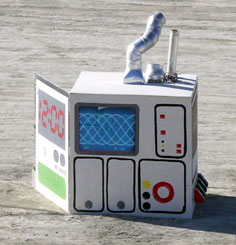
In previous years (2003-2005), electricity was supplied to the camp in an on-demand fashion using one or two gasoline powered Coleman generators (5000-watt and 3000-watt models.) [Ed. note: as of May-2008, the 5000-watt generator has seized and is inoperable. Further ,in 2009 Desicant rebuilt it, but we discovered missing throttle regulator components at the last minute. More work to do...] These generators were typically only run at night when electricity demand was high (lights and sound system.) During the daytime, limited power was provided by a small cluster of deep-cycle lead-acid batteries and inverters. Both generators were pretty reliable, but required frequent refilling and maintenance. Since they were so noisy, they needed to be parked across the street on the other side of the Esplanade and placed inside a box to baffle the noise. In 2006, the camp was positioned next to Entheon Village and were offered 24x7 power as a neighborly courtesy. We utilized only one of our own generators to power a large LED art sculpture, affectionately known as "Spinny".
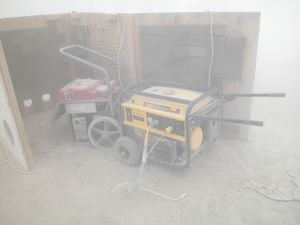
In 2007, Automatic Subconscious along with a handful of other Boston-based camps formed the first Boston Village known as "The Hive". The village jointly agreed to rent a 40kWh diesel generator for the duration of Burning Man. This decision provided very reliable 24x7 power to the whole village at a reasonable cost (~$30/person). The diesel generator was also very quiet and required little-to-no maintenance.
The plan for 2008 is to rent a diesel generator again for the whole village. Despite having 24x7 power, the camp still maintains and ships multiple gasoline generators out to Burning Man. These generators are primarily used for back-up power (in case the main diesel generator fails.) The smaller, portable "inverter generators" (which are owned by camp individuals) are used before the arrival of the primary diesel generator.
The plan for 2009 was to bring two generators, a 5.5kW main generator on loan from welder-Blake, and the 3kW. Cliff also brought his 6.5kW monster. Power was typically provided from dusk until dawn and for events. In the first two days the first two generators had stopped operating, but Cliff's and a loaner 5.5kW worked for the rest of the trip. the 6.5 powered the dome lighting and PA, and the 5.5kW was dedicated to the rest of the camp, allowing selective use based on camp and entertainment needs.
To provide almost 24-hour power to important facilities such as, the freezer, the evap sump pump, battery chargers, and the camp charging station, we ran Xuth's 1kW generator when the camp generator was off. These facilities were all connected to one power strip by the 1kW, and a camp power drop was placed next to the generator to facilitate quick, easy-to-delegate, changeovers.
See the Power and Water: Electricity page for more details on how to implement this.
Theres a sceert about your post. ICTYBTIHTKY
Running Water
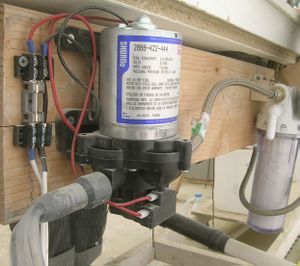
Water is one of the most basic necessities at Burning Man. But "running" water is a luxury item and one that AutoSub has had for a few years now. In 2005, Cris W. lent his water pump set-up to us for use in providing a steady water supply to the camp. Unfortunately, it had some leaks in the system and had trouble keeping the pressure up and would quickly drain our lead-acid batteries requiring frequent recharges of said batteries.
In 2006, Pretzel came up with a similarly designed system based around an RV water pump, water filter, and lead-acid battery using modular plumbing components that go together easily by hand with minimal tools. This design is fast to deploy and quite reliable. It only had a couple minor flaws (which were later remedied in 2007.)
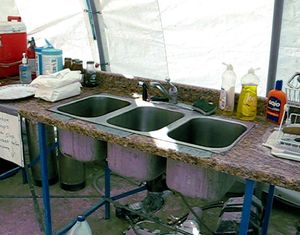
Autosub plans to further improve on the running water supply to the kitchen sink. As it was noticed last year, because the faucet operates just like a normal kitchen sink, most camp members need to be frequently reminded that Burning Man is NOT like living at home:
- The camp has a limited amount of water for the whole week.
- The camp must evaporate any gray water produced from the kitchen sink.
A faucet enables the wasting of water, so it has been proposed that some sort of auto-limiting device be installed so as to encourage frugal use of the water supply. This device will also be temporarily over-ridable as to allow the kitchen cooks to rapidly fill large pots as needed.
See the Power and Water: Running Water page for more details on how to implement this.
Gray Water
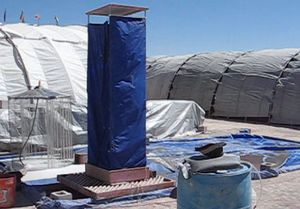
With the use of clean water to wash dishes and bodies comes the production of "gray water". Since there are no septic systems provided by Burning Man, each camp has to find a way to dispose of this mildly dirty, but clearly UN-drinkable water.
For as long as most of us can remember, there has always been an evaporation "pond" (aka. gray water pond) sitting in the middle of the camp, diligently evaporating this waste water into the air. A classic gray water pond consists of:
- A large, brown or black colored plastic tarp (10' x 20' in area; 5 to 15 mils in thickness)
- Enough wooden 2x4s (to line the perimeter of the tarp)
- A bunch of concrete blocks (to hold the 2x4s in place)
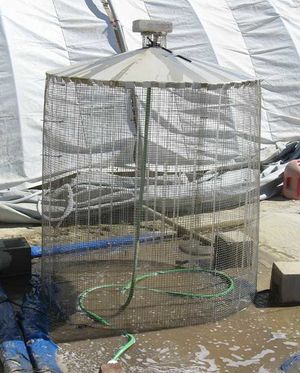
After the gray water has been filtered thru a simple screen, it is disposed of in this pond area to let evaporate under the hot, dry sun. This system is moderately effective at evaporating gray water, but it has its problems:
- As dust settles onto the greasy pond water, evaporation can frequently be hindered.
- The pond can also be a breeding ground for bacteria and other illness vectors.
In 2007, Doug R. and Pretzel engineered an add-on to the gray water pond. This new addition was based on a proven design by previous Burner experience which utilized a bilge pump, 4-foot section of ½" hardware cloth (welded wire mesh), and a sheet metal cone. ( Original evaporator fountain design ) This design radically boosted evaporation rates and only had a few minor problems. The issue of bacteria and other vectors were handled by adding regular doses of chlorine bleach to the gray water. There are plans to automatically dispense chlorine bleach at a regular interval for 2008.
See the Power & Water: Gray Water page for more details on how to implement this.
PS: No peeing in the gray water pond.
PPS: No, I don't care how badly you have to go.
PPPS: No, you can't use my pee bottle. Go get your own, hippie.
That's the best asnwer of all time! JMHO
Inventory
Starting in 2009, we sorted and inventoried all of the Power and Water assets that are stored in Reno. Here's the list.